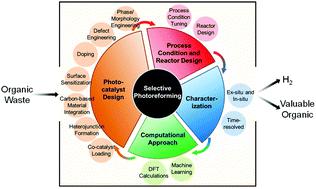当前位置:
X-MOL 学术
›
Energy Environ. Sci.
›
论文详情
Our official English website, www.x-mol.net, welcomes your feedback! (Note: you will need to create a separate account there.)
Advancing photoreforming of organics: highlights on photocatalyst and system designs for selective oxidation reactions
Energy & Environmental Science ( IF 32.5 ) Pub Date : 2021-2-16 , DOI: 10.1039/d0ee03116j Cui Ying Toe 1, 2, 3, 4 , Constantine Tsounis 1, 2, 3, 4 , Jiajun Zhang 1, 2, 3, 4 , Hassan Masood 1, 2, 3, 4 , Denny Gunawan 1, 2, 3, 4 , Jason Scott 1, 2, 3, 4 , Rose Amal 1, 2, 3, 4
Energy & Environmental Science ( IF 32.5 ) Pub Date : 2021-2-16 , DOI: 10.1039/d0ee03116j Cui Ying Toe 1, 2, 3, 4 , Constantine Tsounis 1, 2, 3, 4 , Jiajun Zhang 1, 2, 3, 4 , Hassan Masood 1, 2, 3, 4 , Denny Gunawan 1, 2, 3, 4 , Jason Scott 1, 2, 3, 4 , Rose Amal 1, 2, 3, 4
Affiliation

|
Photoreforming is a process that harnesses the redox ability of photocatalysts upon illumination, to simultaneously drive the reduction of H+ into hydrogen gas and oxidation of organic compounds. Over the past few decades, significant effort has been devoted to improving the photocatalytic hydrogen evolution efficiency, while substantially less focus has been directed towards the oxidation reactions. More recently, the realization of the potential for simultaneous hydrogen production with value-added organics has inspired researchers to use photooxidation pathways to tune the selectivity of oxidized products. As a distinct benefit, the less energetically demanding organic reforming is highly favorable when compared to the slow kinetics of oxygen evolution which negates the need for expensive and/or harmful hole scavengers. Photocatalyst modifications, such as secondary component deposition, doping, defect, phase and morphology engineering, have been the main strategies adopted to tune the photooxidation pathways and oxidation products. Direct control of the process conditions, including pH, temperature and reactant concentration, and favorable reactor designs can further improve the selectivity towards desired products. While other published reviews focus on the types of photocatalysts or feedstocks used to enhance the hydrogen evolution efficiency, this review highlights the importance of controlling the selectivity of the photoreforming reaction, particularly as an alternative path for waste abatement or valorization for industry. This review links the strategies used to improve the selectivity of photoreforming of organic waste into high-value and desirable chemicals, as well as offers an outlook on the future research direction required to deliver highly selective photocatalyst. A holistic strategy that comprises photocatalyst and system designs, appropriate characterizations and implementation of artificial intelligence has also been proposed and discussed to further aid establishment of the structure–mechanism–function relationship, thereby accelerating the discovery of optimum selective photoreforming systems.
中文翻译:

推进有机物的光重整:选择性催化反应的光催化剂和系统设计的重点
光重整是利用光催化剂在照明时的氧化还原能力同时驱动H +还原的过程。转化为氢气和氧化有机化合物。在过去的几十年中,已经致力于改善光催化氢释放效率的大量努力,而对氧化反应的关注则大大减少。最近,实现了利用增值有机物同时生产氢气的潜力,这启发了研究人员使用光氧化途径来调节氧化产物的选择性。作为一个明显的好处,与氧气释放缓慢的动力学相比,对能量要求较低的有机重整是高度有利的,而氧气的缓慢动力学消除了对昂贵和/或有害的空穴清除剂的需求。光催化剂的改性,例如次级组分的沉积,掺杂,缺陷,相和形态工程,已经成为调整光氧化途径和氧化产物的主要策略。直接控制工艺条件,包括pH,温度和反应物浓度,以及有利的反应器设计,可以进一步提高对所需产物的选择性。虽然其他已发表的评论集中在用于提高氢气释放效率的光催化剂或原料的类型上,但该评论强调了控制光重整反应选择性的重要性,特别是作为工业减少废物或增值的替代途径。这篇综述将用于提高有机废物光重整选择性的策略与高价值和理想的化学物质联系起来,并对提供高选择性光催化剂所需的未来研究方向进行了展望。
更新日期:2021-02-18
中文翻译:

推进有机物的光重整:选择性催化反应的光催化剂和系统设计的重点
光重整是利用光催化剂在照明时的氧化还原能力同时驱动H +还原的过程。转化为氢气和氧化有机化合物。在过去的几十年中,已经致力于改善光催化氢释放效率的大量努力,而对氧化反应的关注则大大减少。最近,实现了利用增值有机物同时生产氢气的潜力,这启发了研究人员使用光氧化途径来调节氧化产物的选择性。作为一个明显的好处,与氧气释放缓慢的动力学相比,对能量要求较低的有机重整是高度有利的,而氧气的缓慢动力学消除了对昂贵和/或有害的空穴清除剂的需求。光催化剂的改性,例如次级组分的沉积,掺杂,缺陷,相和形态工程,已经成为调整光氧化途径和氧化产物的主要策略。直接控制工艺条件,包括pH,温度和反应物浓度,以及有利的反应器设计,可以进一步提高对所需产物的选择性。虽然其他已发表的评论集中在用于提高氢气释放效率的光催化剂或原料的类型上,但该评论强调了控制光重整反应选择性的重要性,特别是作为工业减少废物或增值的替代途径。这篇综述将用于提高有机废物光重整选择性的策略与高价值和理想的化学物质联系起来,并对提供高选择性光催化剂所需的未来研究方向进行了展望。


























 京公网安备 11010802027423号
京公网安备 11010802027423号